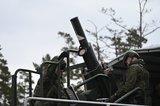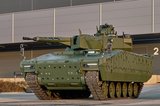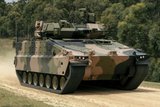US Army seeks nearly $900 million to accelerate development and acquisition of CUAS capabilities
A soldier uses a handheld CUAS system during training in Colorado. (Photo: US Army)
The US Army has proposed a nearly $900 million investment in counter-UAS capabilities in FY2026, aiming to accelerate the procurement and fielding of this type of technology. According to the service’s justification documents, advancing the deployment of CUAS solutions is a “priority line of effort” for the next fiscal year.
The resources will cover efforts related to kinetic and non-kinetic systems, including fixed, semi-fixed, mounted, dismounted and handheld devices, as well as to the use of directed energy, fire control, laser and EW capabilities.
“We are testing all of those systems, and we need to scale them,” the branch’s
Already have an account? Log in
Want to keep reading this article?
More from Land Warfare
-
How Patria TREMOS redefines battlefield mobility
The war in Ukraine has made it clear: the battlefield waits for no one. Military operations now take place in fast-paced environments, and speed is not just about the fight itself – it is about the entire ecosystem of warfare.
-
![Romania set to order KF41 Lynx infantry fighting vehicles]()
Romania set to order KF41 Lynx infantry fighting vehicles
Romania’s effort to buy infantry fighting vehicles is expected to include five configurations: a standard platform with a 30mm autocannon, a command variant, an armoured recovery vehicle, a medical evacuation vehicle and a 120mm self-propelled mortar.
-
![Team LionStrike polishes British Army vehicle offering for Land Mobility Programme]()
Team LionStrike polishes British Army vehicle offering for Land Mobility Programme
Team LionStrike has demonstrated its offering for the British Army’s Land Mobility Programme with plans to bid the Chevrolet Silverado and two variants of the platform: the Infantry Squad Vehicle and General Support Utility Platform.
-
![South Korean companies turning necessity into export opportunity]()
South Korean companies turning necessity into export opportunity
South Korea’s particular geopolitical situation and threat environment has created a defence industry ecosystem of substantial size and breadth.
-
![Still no clarity on the future of the British Army’s new wheeled artillery system]()
Still no clarity on the future of the British Army’s new wheeled artillery system
The UK donated its AS90 155mm/39cal tracked self-propelled howitzers to Ukraine ahead of planned retirement and bought Archer platforms to fill the gap. Eventually RCH 155s were ordered but the procurement effort remains under a cloud.























